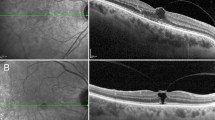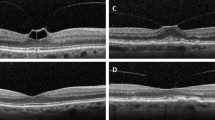Abstract
Vitreomacular traction (VMT) is characterised by abnormal adhesion of the posterior cortical vitreous with the macula causing distortion of the foveal contour and associated with symptoms of reduction in visual acuity and/or metamorphopsia. This review article explores the pathophysiology, clinical features, diagnostic and treatment options for VMT. Advances in imaging modalities such as optical coherence tomography (OCT) have revolutionized the understanding of the vitreoretinal interface abnormalities and helps in monitoring the disease progression. The natural history of VMT is variable and either there can be a spontaneous resolution or can present with cystoid oedema or can progress to epiretinal membrane (ERM) or macular hole. In the current manuscript, we perform a major review of the existing literature on VMT and adding the details about the current investigative modalities and surgical techniques.
This is a preview of subscription content, access via your institution
Access options
Subscribe to this journal
Receive 18 print issues and online access
$259.00 per year
only $14.39 per issue
Buy this article
- Purchase on SpringerLink
- Instant access to full article PDF
Prices may be subject to local taxes which are calculated during checkout


Similar content being viewed by others
References
De Smet MD, Gad Elkareem AM, Zwinderman AH. The Vitreous, the Retinal Interface in Ocular Health and Disease. Ophthalmologica. 2013;230:165–78.
Sebag J. Anatomy and pathology of the vitreo-retinal interface. Eye. 1992;6:541–52.
Halfter W, Sebag J, Cunningham ET. II.E. Vitreoretinal Interface and Inner Limiting Membrane. In: Sebag J, editor. Vitreous [Internet]. New York, NY: Springer New York; 2014 [cited 2024 Aug 23]. p. 165–91. Available from: https://link.springer.com/10.1007/978-1-4939-1086-1_11.
Johnson MW. Posterior Vitreous Detachment: Evolution and Complications of Its Early Stages. Am J Ophthalmol. 2010;149:371–382.e1.
Sebag J. Anomalous posterior vitreous detachment: a unifying concept in vitreo-retinal disease. Graefes Arch Clin Exp Ophthalmol. 2004;242:690–8.
Le Goff MM, Bishop PN. Adult vitreous structure and postnatal changes. Eye. 2008;22:1214–22.
Levison AL, Kaiser PK. Vitreomacular interface diseases: Diagnosis and management. Taiwan J Ophthalmol. 2014;4:63–8.
Jackson TL, Nicod E, Simpson A, Angelis A, Grimaccia F, Kanavos P. Symptomatic Vitreomacular Adhesion. Retina. 2013;33:1503–11.
Petrou P, Chalkiadaki E, Errera MH, Liyanage S, Wickham L, Papakonstantinou E, et al. Factors Associated with the Clinical Course of Vitreomacular Traction. Thomas BB, editor. J Ophthalmol. 2020 Dec 21;2020:1–7.
Shao L, Zhang C, Dong L, Zhou WD, Zhang RH, Wei WB. Prevalence and Associations of Vitreomacular Traction: The Beijing Eye Study. Int J Gen Med. 2021;ume 14:7059–64.
Liew G, Nguyen H, Ho IV, White AJ, Burlutsky G, Gopinath B, et al. Prevalence of Vitreoretinal Interface Disorders in an Australian Population. Ophthalmol Sci. 2021;1:100019.
Meuer SM, Myers CE, Klein BEK, Swift MK, Huang Y, Gangaputra S, et al. The Epidemiology of Vitreoretinal Interface Abnormalities as Detected by Spectral-Domain Optical Coherence Tomography. Ophthalmology. 2015;122:787–95.
Bottós J, Elizalde J, Arevalo JF, Rodrigues EB, Maia M. Vitreomacular Traction Syndrome. J Ophthalmic Vis Res. 2012;7:148–61.
Bottos J, Elizalde J, Rodrigues EB, Farah M, Maia M. Vitreomacular Traction Syndrome: Postoperative Functional and Anatomic Outcomes. Ophthalmic Surg Lasers Imaging Retin. 2015;46:235–42.
Steel DHW, Lotery AJ. Idiopathic vitreomacular traction and macular hole: a comprehensive review of pathophysiology, diagnosis, and treatment. Eye. 2013;27:S1–21.
Jackson TL, Nicod E, Angelis A, Grimaccia F, Prevost AT, Simpson ARH, et al. Vitreous Attachment In Age-Related Macular Degeneration, Diabetic Macular Edema, And Retinal Vein Occlusion: A Systematic Review and Metaanalysis. Retina. 2013;33:1099–108.
Chang LK, Fine HF, Spaide RF, Koizumi H, Grossniklaus HE. Ultrastructural Correlation of Spectral-Domain Optical Coherence Tomographic Findings in Vitreomacular Traction Syndrome. Am J Ophthalmol. 2008;146:121–7.
Hikichi T, Yoshida A, Trempe CL. Course of Vitreomacular Traction Syndrome. Am J Ophthalmol. 1995;119:55–61.
Gandorfer A. Epiretinal pathology of vitreomacular traction syndrome. Br J Ophthalmol. 2002;86:902–9.
Flaxel CJ, Adelman RA, Bailey ST, Fawzi A, Lim JI, Vemulakonda GA, et al. Idiopathic Epiretinal Membrane and Vitreomacular Traction Preferred Practice Pattern®. Ophthalmology. 2020;127:P145–83.
Carpineto P, Ciciarelli V, Borrelli E, Aharrh-Gnama A, Mastropasqua R. Epiretinal Membrane In Eyes With Vitreomacular Traction. Retina. 2019;39:1061–5.
Johnson MW. Tractional Cystoid Macular Edema: A Subtle Variant of the Vitreomacular Traction Syndrome. Am J Ophthalmol. 2005;140:184.e1–184.e10.
Bottós J, Elizalde J, Rodrigues EB, Farah M, Maia M. Classifications of vitreomacular traction syndrome: diameter vs morphology. Eye. 2014;28:1107–12.
Sonmez K, Capone A, Trese MT, Williams GA. Vitreomacular Traction Syndrome: Impact of Anatomical Configuration on Anatomical and Visual Outcomes. Retina. 2008;28:1207–14.
Duker JS, Kaiser PK, Binder S, De Smet MD, Gaudric A, Reichel E, et al. The International Vitreomacular Traction Study Group Classification of Vitreomacular Adhesion, Traction, and Macular Hole. Ophthalmology. 2013;120:2611–9.
Lee EK, Lee SY, Lee JY, Heo JW, Yu HG, Chung H. Anatomical configurations of vitreomacular traction syndrome: influence on clinical course and surgical outcomes. Graefes Arch Clin Exp Ophthalmol. 2019;257:1631–9.
John VJ, Flynn HW, Smiddy WE, Carver A, Leonard R, Tabandeh H, et al. Clinical Course Of Vitreomacular Adhesion Managed By Initial Observation. Retina. 2014;34:442–6.
Koizumi H, Spaide RF, Fisher YL, Freund KB, Klancnik JM, Yannuzzi LA. Three-Dimensional Evaluation of Vitreomacular Traction and Epiretinal Membrane Using Spectral-Domain Optical Coherence Tomography. Am J Ophthalmol. 2008;145:509–517.e1.
Tsunoda K, Watanabe K, Akiyama K, Usui T, Noda T. Highly Reflective Foveal Region in Optical Coherence Tomography in Eyes with Vitreomacular Traction or Epiretinal Membrane. Ophthalmology. 2012;119:581–7.
Pandya BU, Grinton M, Mandelcorn ED, Felfeli T. Retinal Optical Coherence Tomography Imaging Biomarkers: A Review of the Literature. Retina [Internet]. 2023 Dec 20 [cited 2024 Sep 2]; Available from: https://journals.lww.com/10.1097/IAE.0000000000003974.
Almeida DRP, Chin EK, Rahim K, Folk JC, Russell SR. Factors Associated With Spontaneous Release Of Vitreomacular Traction. Retina. 2015;35:492–7.
Nawrocka ZA, Nawrocka Z, Nawrocki J. Swept-Source Optical Coherence Tomography Angiography in Vitreomacular Traction Syndrome. J Vitreoretin Dis. 2022;6:31–9.
Errera MH, Liyanage SE, Petrou P, Keane PA, Moya R, Ezra E, et al. A Study of the Natural History of Vitreomacular Traction Syndrome by OCT. Ophthalmology. 2018;125:701–7.
Stalmans P. A retrospective cohort study in patients with tractional diseases of the vitreomacular interface (ReCoVit). Graefes Arch Clin Exp Ophthalmol. 2016;254:617–28.
Tzu JH, John VJ, Flynn HW, Smiddy WE, Jackson JR, Isernhagen BA, et al. Clinical Course of Vitreomacular Traction Managed Initially by Observation. Ophthalmic Surg Lasers Imaging Retin. 2015;46:571–6.
Larsson J. Vitrectomy in vitreomacular traction syndrome evaluated by ocular coherence tomography (OCT) retinal mapping. Acta Ophthalmol Scand. 2004;82:691–4.
Patel V, Kiryakoza L, Chau V, Patel A, Yannuzzi NA, Flynn HW, et al. Idiopathic Vitreomacular Traction Managed with Initial Observation. Ophthalmol Retin. 2022;6:893–8.
Theodossiadis GP, Grigoropoulos VG, Theodoropoulou S, Datseris I, Theodossiadis PG. Spontaneous Resolution of Vitreomacular Traction Demonstrated by Spectral-Domain Optical Coherence Tomography. Am J Ophthalmol. 2014;157:842–851.e1.
Odrobina D, Michalewska Z, Michalewski J, Dzięgielewski K, Nawrocki J. Long-Term Evaluation Of Vitreomacular Traction Disorder In Spectral-Domain Optical Coherence Tomography. Retina. 2011;31:324–31.
De Smet MD, Gandorfer A, Stalmans P, Veckeneer M, Feron E, Pakola S, et al. Microplasmin Intravitreal Administration in Patients with Vitreomacular Traction Scheduled for Vitrectomy. Ophthalmology. 2009;116:1349–1355.e2.
Khan MA, Haller JA. Ocriplasmin for Treatment of Vitreomacular Traction: An Update. Ophthalmol Ther. 2016;5:147–59.
Mec-Słomska A, Adamiec-Mroczek J, Kuźmicz E, Misiuk-Hojło M. Intravitreal ocriplasmin: A breakthrough in the treatment of vitreomacular traction? Adv Clin Exp Med. 2017;26:527–31.
Stalmans P, Benz MS, Gandorfer A, Kampik A, Girach A, Pakola S, et al. Enzymatic Vitreolysis with Ocriplasmin for Vitreomacular Traction and Macular Holes. N. Engl J Med. 2012;367:606–15.
Varma R, Haller JA, Kaiser PK. Improvement in Patient-Reported Visual Function After Ocriplasmin for Vitreomacular Adhesion: Results of the Microplasmin for Intravitreous Injection–Traction Release Without Surgical Treatment (MIVI-TRUST) Trials. JAMA Ophthalmol. 2015;133:997.
Jackson TL, Haller J, Blot KH, Duchateau L, Lescrauwaet B. Ocriplasmin for treatment of vitreomacular traction and macular hole: A systematic literature review and individual participant data meta-analysis of randomized, controlled, double-masked trials. Surv Ophthalmol. 2022;67:697–711.
Dugel PU, Tolentino M, Feiner L, Kozma P, Leroy A. Results of the 2-Year Ocriplasmin for Treatment for Symptomatic Vitreomacular Adhesion Including Macular Hole (OASIS) Randomized Trial. Ophthalmology. 2016;123:2232–47.
Lescrauwaet B, Duchateau L, Verstraeten T, Jackson TL. Visual Function Response to Ocriplasmin for the Treatment of Vitreomacular Traction and Macular Hole: The OASIS Study. Investig Opthalmol Vis Sci. 2017;58:5842.
Haynes RJ, Yorston D, Laidlaw DAH, Keller J, Steel DHW. Real world outcomes of ocriplasmin use by members of the British and Eire Association of Vitreoretinal Surgeons. Eye. 2017;31:107–12.
Johnson MW. How Should We Release Vitreomacular Traction: Surgically, Pharmacologically, or Pneumatically? Am J Ophthalmol. 2013;155:203–205.e1.
Steinle NC, Dhoot DS, Quezada Ruiz C, Castellarin AA, Pieramici DJ, See RF, et al. Treatment Of Vitreomacular Traction With Intravitreal Perfluoropropane (C3f8) Injection. Retina. 2017;37:643–50.
Rodrigues IA, Stangos AN, McHugh DA, Jackson TL. Intravitreal Injection of Expansile Perfluoropropane (C3F8) for the Treatment of Vitreomacular Traction. Am J Ophthalmol. 2013;155:270–276.e2.
Chan CK, Mein CE, Glassman AR, Beaulieu WT, Calhoun CT, Jaffe GJ, et al. Pneumatic Vitreolysis with Perfluoropropane for Vitreomacular Traction with and without Macular Hole. Ophthalmology. 2021;128:1592–603.
Kumar V, Sonkar R, Verma S, Azad SV, Chawla R, Venkatesh P, et al. Pneumatic Vitreolysis Versus Pars Plana Vitrectomy In Focal Symptomatic Vitreomacular Traction Syndrome: A Randomized Trial. Retina. 2022;42:1277–83.
Jackson TL, Nicod E, Angelis A, Grimaccia F, Prevost AT, Simpson ARH, et al. Pars Plana Vitrectomy For Vitreomacular Traction Syndrome: A Systematic Review and Metaanalysis of Safety and Efficacy. Retina. 2013;33:2012–7.
Petrou P, Kontos A, Errera MH, Banerjee PJ, Liyanage SE, Wickham L, et al. Pars Plana Vitrectomy for Vitreomacular Traction Syndrome: Analysing the Preoperative Prognostic Factors. Semin Ophthalmol. 2018;33:313–7.
Smiddy WE, Michels RG, Glaser BM, deBustros S. Vitrectomy for Macular Traction Caused by Incomplete Vitreous Separation. Arch Ophthalmol. 1988;106:624–8.
Yamada N, Kishi S. Tomographic features and surgical outcomes of vitreomacular traction syndrome. Am J Ophthalmol. 2005;139:112–7.
Witkin AJ, Patron ME, Castro LC, Reichel E, Rogers AH, Baumal CR, et al. Anatomic and Visual Outcomes of Vitrectomy for Vitreomacular Traction Syndrome. Ophthalmic Surg Lasers Imaging Retin. 2010;41:425–31.
Morescalchi F, Costagliola C, Gambicorti E, Duse S, Romano MR, Semeraro F. Controversies over the role of internal limiting membrane peeling during vitrectomy in macular hole surgery. Surv Ophthalmol. 2017;62:58–69.
Morescalchi F, Russo A, Semeraro F. Surgical Outcomes Of Vitreomacular Traction Treated With Foveal-Sparing Peeling Of The Internal Limiting Membrane. Retina. 2021;41:2026–34.
Díaz-Valverde A, Wu L. To Peel Or Not To Peel The Internal Limiting Membrane In Idiopathic Epiretinal Membranes. Retina. 2018;38:S5–11.
Ehlers JP, Tam T, Kaiser PK, Martin DF, Smith GM, Srivastava SK. Utility Of Intraoperative Optical Coherence Tomography During Vitrectomy Surgery For Vitreomacular Traction Syndrome. Retina. 2014;34:1341–6.
Huang HJ, Sevgi DD, Srivastava SK, Reese J, Ehlers JP. Vitreomacular Traction Surgery from the DISCOVER Study: Intraoperative OCT Utility, Ellipsoid Zone Dynamics, and Outcomes. Ophthalmic Surg Lasers Imaging Retin. 2021;52:544–50.
Acknowledgements
This work was funded by the Hyderabad Eye Research Foundation.
Author information
Authors and Affiliations
Contributions
MK, VPD – Conceptualized, wrote, and finalized the manuscript. FMR, ABS, MPS, YTH, TTL, SS, LL, LW, LOH, AP, and RRP all provided critical inputs, changes and proof read the final draft and finalized it.
Corresponding author
Ethics declarations
Competing interests
The authors declare no competing interests.
Additional information
Publisher’s note Springer Nature remains neutral with regard to jurisdictional claims in published maps and institutional affiliations.
Supplementary information
Rights and permissions
Springer Nature or its licensor (e.g. a society or other partner) holds exclusive rights to this article under a publishing agreement with the author(s) or other rightsholder(s); author self-archiving of the accepted manuscript version of this article is solely governed by the terms of such publishing agreement and applicable law.
About this article
Cite this article
Ketkar, M., Dave, V.P., de Ribot, F.M. et al. Vitreomacular traction – a review. Eye 39, 710–717 (2025). https://doi.org/10.1038/s41433-024-03576-2
Received:
Revised:
Accepted:
Published:
Issue date:
DOI: https://doi.org/10.1038/s41433-024-03576-2
This article is cited by
-
Potential of autophagy in subretinal fibrosis in neovascular age-related macular degeneration
Cellular & Molecular Biology Letters (2025)



